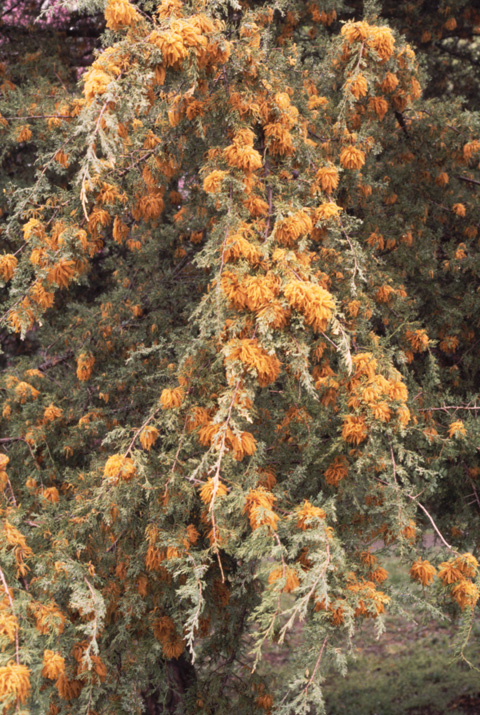
Figure #1 - Cedar apple rust spots.
Gardening with Chuck©
Cedar Apple Rust
It's mid to late summer and you notice that the leaves on your apple tree are thin, somewhat off color and they have these yellow spots with brown centers (Figure 1). So what's going on?

Figure #1 - Cedar apple rust spots.
Your apple tree, either flowering crab apple or a fruiting variety, has cedar apple rust. As its name implies, cedar apple rust is a disease that is shared between cedar trees and apple trees. The disease is fatal to neither cedars (junipers) nor apples. But the disease can weaken apple trees reducing fruit production or overall vigor and make them more susceptible to other diseases and early age decline.
In mid spring (late April through May) galls on the cedar trees release spores from odd, alien looking fruiting structures (figure 2) the appear shortly after warm spring showers.

Figure #2 - Cedar apple rust galls on a cedar tree in the
spring.
Spores are released from the jellyfish looking tentacles.
The spores can float on the wind and travel up to one half mile. If the spores land on a susceptible, unprotected apple tree leaf, they will quickly infect the leaf. Fungicidal protection needs to be applied, to susceptible apple varieties, before a spore release or you will wind up with leaves that look like Figure 3.

Figure #3 - Multiple cedar apple rust infection lesions.
In late summer and early autumn, following rain storms, short "horns" will develop from these spots on the underside or backside of the leaf. Spores will be released from these horns and re-infect the cedar trees. These galls will grow and develop on the cedar tree for all of the entire next year and will not mature until the year after next, in the spring, when they will again release spores to infect apple trees.
There are two ways to deal with this disease in apple trees. The first is to plant varieties resistant to cedar apple rust, the second way is to spray protective fungicides. We'll talk about fungicides first. We have found it to be basically a waste of time to try to prevent cedar trees from getting the disease. The foliage is too thick to obtain thorough coverage, the infection period, in the late summer and fall, is far to lengthy to justify the expense and time and there are generally just too many cedar trees in most areas to treat. However, the spring infection period is much shorter and it is easier to spray the susceptible apple trees. We are usually far more concerned about the apple trees, anyway. Treatment should commence when the first orange tendrils are seen on the galls in the cedar trees. Generally this will be in mid April in northern Kansas. Spray every 7 to 10 days until the galls quit shedding spores, usually in late May. Fungicides that can be used include: Ferbam, triforine (Funginex, labeled for apples only), chlorothalonil (Daconil 2787, crabapple only), myclobutanil (Immunox - apple or flowering crab, Eagle, Systhane - both for flowering crab only, and Rally - apple only) and triadimefon (Bayleton). If you are also trying to control apple scab, then you should use an appropriate myclobutanil product. Be sure to read and follow label directions and apply a thorough covering spray.
A better approach is to plant resistant varieties. Not all apple trees and flowering crabs react the same to cedar apple rust. Apple varieties like Jonathan, Braeburn and Golden Delicious are very susceptible to cedar apple rust. Varieties like Red Delicious, McIntosh, Empire, Granny Smith and Winesap are resistant. Figure 4 shows the difference between a resistant and susceptible apple variety planted side by side.

Figure #4 - Cedar apple rust resistant Red Delicious on the left
and
susceptible Jonathan on the right.
Additional information on cedar apple rust can be found at the K-State Research and Extension website, click here for information from Extension Horticulture or here for information from Extension Plant Pathology.
Text and all photos copyrighted by Chuck Otte.
August 2008